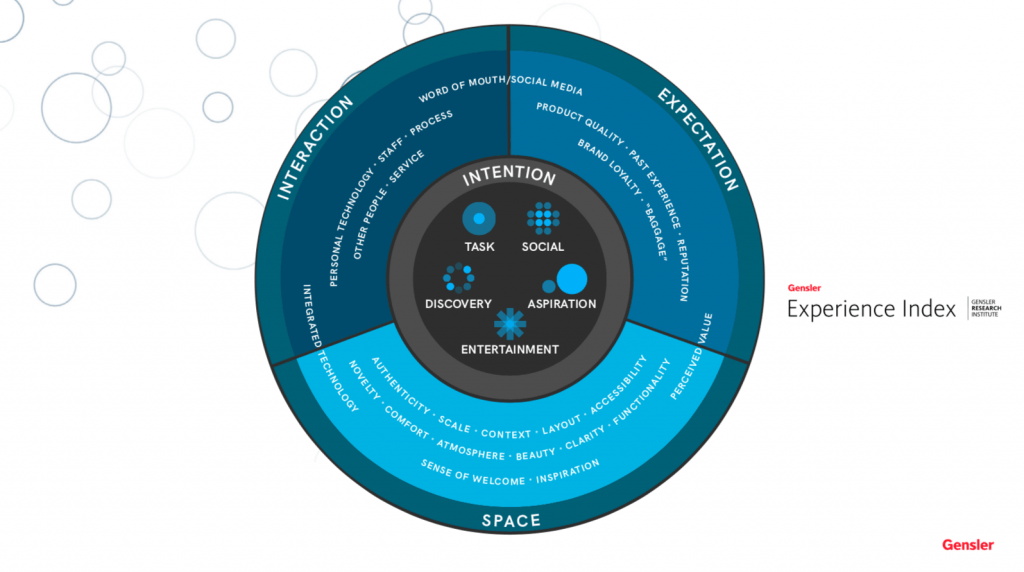
Every patient wants a great experience, right?
But how can you design for the optimal patient experience? It starts with the “why” because a fundamental element of designing for experience is to understand a person’s intention and how it frames their experience.
That’s what Gensler discovered a few years ago when it set out to 1) identify the factors of a great experience; 2) quantify the impact of design on experience; and 3) understand the ways in which design makes the biggest difference.
The Gensler Experience Index, developed by the Gensler Research Institute, is the result of a rigorous, mixed-methods investigation that combined qualitative, ethnographic research with quantitative research that included a national survey.
I came across this research when collaborating with Tama Duffy Day, Principal and Health & Wellness Leader at Gensler, to lead an interactive discussion on the patient experience at last year’s Healthcare Design Expo & Conference.
Last week, Tama and I teamed up again to lead a webinar for The Center for Health Design based on our HCD session. Here’s some of what she shared about The Gensler Experience Index.
It Starts With Intention
Tama explained that a person’s intention when engaging with a space dictates how they evaluate their experience and helps us understand which design factors can support what makes them have a great experience.
Gensler’s qualitative research identified five universal intentions or “modes” of experience that are at the center of the Gensler Experience Index:
- Task: This is when people have something specific they are trying to accomplish. They are typically very focused and direct. They seek spaces that are efficient, pragmatic, and easy to navigate – typically not open to distractions.
- Social: This is when people’s main intention is to engage with other people. Spaces that support social connection and a sense of community are really important for them.
- Discovery: People in this mode do not have a concrete plan. They might be killing time between activities and are likely to wander and explore. Spaces focusing less on clarity and more on inspiration, authenticity, and novelty meet their needs.
- Entertainment: This is where people are looking to be entertained and brought away from every day life. Spaces designed for this type of experience have novel and unique positive distractions and design features.
- Aspiration: In this mode, people are seeking to grow, expand, or be connected to a larger purpose. Providing opportunities for personal growth, inspiration, and engagement are crucial to them.
“While the modes are distinct mindsets with their own implications, people can toggle between modes inside of one experience,” Tama said. “When they do that, it improves their experience.”
What Else Frames a Person’s Experience?
After understanding intention, Tama said that there are three other framing elements that inform a person’s experience:
- Expectation: This includes past experience with the brand or space, word of mouth, and also “baggage” or context they bring with themselves to an experience. For instance, are they in a bad mood?
- Interaction: Once they are in the experience, the qualities of interaction also play a huge role in how it will be perceived. In healthcare a lot of this is about staff and service. Are people welcoming and knowledgeable? Is the physician clear in their communication to the patient?
- Space: Then, of course, there is the importance of the physical space. Gensler’s survey measured over 75 factors, some of which the most important are beauty, scale, layout, accessibility, and sense of welcome.
“One crucial finding in Gensler’s research is that design of the physical environment has a significant, quantifiable impact on the quality of the experience,” Tama added.
For example, people who rated the design of the space they visited as “excellent” rated the quality of their experience in that space nearly twice as high as spaces where the design was not rated “excellent.”
Applying the Gensler Experience Index to Healthcare
Does the Gensler Experience Index resonate with those in the healthcare industry? Gensler hosted six roundtable discussions across the country to find out.
Attendees included clinical practitioners, academic medicine strategists, and CEOs from community centers and federally qualified health centers, university fellows, real estate brokers, educators, and healthcare consulting executives.
“To keep the conversations in each of the six cities focused, Gensler asked the same series of questions, but each roundtable had it’s own unique flow,” Tama said.
The question that got the most heated discussion was: “Will traditional healthcare providers create memorable experiences that attract and maintain their healthcare consumers and keep them loyal?”
Tama said that several providers did not think this was needed and others loudly shared their differing opinion stating why it was important. Despite this, there were five takeaways about the patient experience that everyone agreed with:
- Silos must be broken
- Satisfaction is not experience
- Purpose inspires and motivates
- In-between time isn’t wasted time
- Experience needs measurement
Want to Know More?
Visit Gensler’s website for more information on the Gensler Experience Index. The webinar Tama and I presented, “Patient Experience: The ‘X’ Factor of Design,” is also available on-demand from The Center for Health Design.
And if you attended the webinar or have any thoughts or ideas about the patient experience, please share them in the comment box below!
P.S. Please do me a favor — if you liked this post and like this blog, please share it with others by sending them the link or posting it on your Twitter, LinkedIn, or Facebook. Also, don’t forget to subscribe, so you’ll get emails when new content is posted. Thanks!
If you like this post, please share.

What’s my story? I’m a healthcare and senior living design knowledge expert who writes and speaks frequently about trends and issues affecting these two industries. I’m also a strategic marketing consultant and content creator, working with companies and organizations who want to improve the quality of healthcare and senior living through the design of the physical environment. You can reach me at sara@saramarberry.com.



2 Responses
“One crucial finding in Gensler’s research is that design of the physical environment has a significant, quantifiable impact on the quality of the experience”
The built environment may be necessary and how Gensler makes their bones, but beautiful spaces have negligible (maybe even detrimental) impact on people who are scared, confused, unsure of what’s expected of them, what will happen to them and when. This article does not address the importance of communication, emotion and understanding (intangible, but IMO more important than the architecture) in any sort of healthcare interaction. Before, during and after the healthcare intervention. If spaces and systems are designed to support seamless communication (leadership to clinician, clinician to patient, patient to leadership) then Gensler really has something going. If not, they’re missing a huge part of the healthcare equation.
Hate to rant, but that’s my two cents, Sara. Thanks for posting!
Thanks for your comments, Mark! I think Gensler’s framing element of “interaction” includes some, if not all, of what you mention. My summary post did not delve into this enough, but communication on many levels is clearly important to the patient experience.